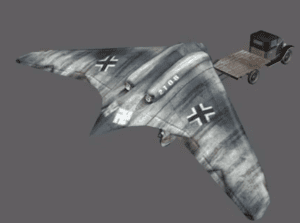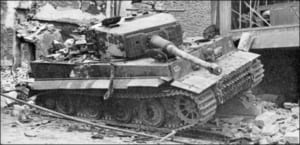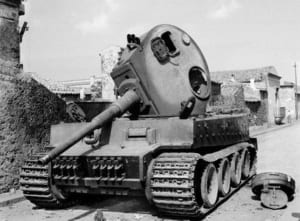Another extremely common belief perpetuated by WWII video games is the idea that the Nazis were an immensely competent and tech savvy force unlike any the world had ever seen and, some argue, won’t ever see again.
It’s often believed that Nazi science and technology were so grand and amazing that the Allied powers were like cavemen compared to them, struggling to even keep up, or that the allies could only win through acts of skulking subterfuge and sabotage.
The reality is quite different.
Ubermensch!
We’ve all seen this in WWII video games: this consistent portrayal of Nazis as some sort of utterly unassailable force of ultimate power that was just barely vanquished.
While sabotage was a very important part of WWII, the way video games portray this gives the impression that the Allies COULDN’T win WWII by conventional means because the Germans were just too advanced. Medal of Honor was a series of games that thrived on this premise during its WWII phase. Medal of Honor: Frontline has you running around Europe in search of a top-secret Nazi jet fighter…. Medal of Honor: European Assault has you running around Europe, destroying V2 rockets, Tiger tank prototypes, and ultimately a ‘dirty bomb’… and so on. More often than not, it would put you in the shoes of a lone covert agent, sabotaging Nazi ‘wonder weapons’ that the Allies weren’t capable of making on their own. It portrayed the Allies as only being able to defeat Nazi Germany on unequal ground, through subterfuge and sabotage rather than simply outmatching the Nazis at their own game.

The sentiment that Nazis were almost unbeatable and miles above the Allies when it came to technology can be found repeated in current popular WWII games, such as Red Orchestra and World of Tanks. Often you see players drone on and on about how overpowered German teams are merely reflecting a historical reality.
Buying into this myth to any degree is literally taking the idea of the Aryan Ubermensch at face value and accepting that the Nazis HAD a legitimate reason to believe they were the Aryan Ubermensch. Why, just look at all the conquering they did! Look at their tanks! Their rockets!
…. Or not.
Nazis were never as advanced as many people seem to think they were.
Most of the enemies they went up against in the first few years of the war were disorganized, poorly equipped and far from being industrial or economic giants. The Nazis couldn’t support long term warfare in any capacity, industrially or economically. This became most evident when Operation Barbarossa stalled and failed after five months of grueling warfare in the Soviet Union.
Their victories in the years of ’39-’41 were all quick and decisive affairs against far weaker opponents like Denmark, Norway, Belgium, Yugoslavia and the Netherlands. They carefully picked enemies they knew they could defeat. It’s a smart strategy but, think of it this way: it’s more akin to a school yard bully picking on a visibly weakest child in the class, and then later getting their ass handed to them by that kid’s much larger, older, brothers.
Industrially, the Germans were nowhere near on the level of either the US, the USSR or the UK. As an example, let’s look at tank production: the most produced German armored fighting vehicle of the war, the StugIII, clocked in at around 10,090 units. Their most produced medium tank, the Panzer IV, came in at 8,500.
The most produced Soviet tank, the T-34 (both models), came in at a staggering 80,000+, and this is from the people the Nazis considered to be literally subhuman.

The Nazis constantly struggled with mechanization. For much of the war, most of their transport was horse drawn, and as the industry completely died, horses outnumbered vehicular transport by a wide margin. There were 625,000 horses saddled up and ready for operation Barbarossa alone (pg. 131-132) Far from the image of hundreds of tanks and APCs riding gloriously across the Russian and Ukranian steppes. By the end of the war, the Germans were struggling to equip their army with trucks… and then decided to waste valuable materials on expensive and resource intensive weapons projects that yielded poor results.
It doesn’t just stop at logistical issues, either. In nearly every WWII game, Nazi tanks are portrayed as the most feared and unassailable presence on the battlefield. The Tiger I tank is typically portrayed as a technological wonder tank. It’s portrayed as an unbeatable, hulking, monstrosity, and the go-to example of Nazi technological brilliance.
In video games like Medal of Honor: Airborne, it’s first shown to us from low angle shots meant to make us feel tiny and intimidated in front of it’s massive, all-consuming presence, as the very ground quakes beneath it.

In reality, it was unreliable, extremely expensive, difficult to maintain, repair, and manufacture, and it’s operational record is less than stellar. Even it’s apparent advantages were temporary and not a guarantee of any resounding success. The Sherman and the T-34 were adequate enough in many cases to defeat it. The Tiger I reached a measly production number of 1,350, and most of them were completely destroyed during the war. Most Allied tank crews never came face to face with it in actual combat situations.
And despite having us believe that it was undefeatable it was uh… defeated. Often by it’s own logistics train. Many broke down en-route to combat. It needed to be transported by railways even on short distances that the Sherman or the T-34 could simply drive over. And even then, it needed to be placed onto the train by a crane. They couldn’t even go over bridges. The quality of tank armor was so poor that enemy tanks didn’t even need to go through the armor to kill the crew. Spalling from high explosive shells detonating close to it did the job enough.
Much the same can be said for the Panther tank, another go-to example. Although the Panther had the added disadvantage of constantly catching on fire.
The allegedly superior German heavy tanks were, at Lisow and beyond, utterly annihilated by Soviet tanks. They were also annihilated by Shermans at Arracourt. This contrasts greatly with how the Tiger is portrayed in, for example, Call of Duty, where US tanks are literally powerless against it, even at point blank range.

But war doesn’t work like a video game.
Another video game favorite is the Nazi rocket planes. The V1 and V2 rocket projects are also often portrayed as wonders of invention. A level in Medal of Honor: European Assault has you lead an entire military operation to destroy a prototype V2. The reality is far less impressive.
As with other Nazi projects it was born out of desperation, and it shows in the results. Their targeting systems were so bad they missed entire cities. The entire V1/V2 project cost three times more than the entire Manhattan project, with two to three times less effective results. The project killed more slaves working on it than it did while in use against cities in the UK.
Super heavy guns such as the Dora and the Schwerer Gustav look really impressive in video games, but are significantly less impressive in real life. They were gigantic, hulking, guns that required a crew of 2750 engineers and workmen to operate; it took half an hour just to reload, let alone fire. They were massive wastes of resources and their effect was minimal. The Allies accomplished much more with the artillery they already had than with these supposed ‘superweapons.’
The Nazis weren’t even pioneers in many of the things commonly attributed to them. Rocketry was a field that was quite extensively researched before the war, and they weren’t even the only ones to test jet aircraft. The difference was that the Allies understood it was a senseless waste to focus on high-tech weaponry that they (at the time, obviously we found use for these things later) couldn’t afford or support. Their decisions were calculated and economical.
The Allies focused on things they can reliably manufacture, repair and maintain in large numbers. The Soviets especially were masterful at this. They carefully considered their capabilities, their situation and came away with a logical plan that eventually led them to victory, while the Germans lagged behind significantly. And Soviet victory came quick, less than a year after launching their counter-offensive Bagration!

By looking at tank production in particular we get to see how each power approached their own industries. The Nazis focused extensively on practices that reduced their overall industrial output at greater resource, manpower, man-hour, and monetary cost, which they could not support in the long run.
By contrast, the T-34 was intentionally made not to last, but that meant they could compensate for it’s short lifespan with extreme ease of production and repair. The Allies focused on sustainable, quick, and significant output they could afford, easily maintain, repair and would last them into the long term.
One of these clearly worked far better since the Allies won.
The Germans DID have a nuclear program developing but it was a far cry from US efforts. Most of the scientists fled to the US and the Germans were never as enthusiastic towards the development of a nuke as the Americans or Soviets were. Education of scientists and engineers also suffered due to the absence of Jewish scientists, destruction of their work, and the influence of the nationalistic movement of ‘Deustchephysik’, which branded all work by Jewish scientists as inherently inferior and untrustworthy. The project was set back when 11 Norwegian commandos destroyed the German supply of heavy water, used in the production of nuclear weapons, without firing a single shot.
Then, for good measure, the British destroyed a ferry carrying the heavy water that the Germans did manage to save.
And so…
In conclusion, the idea that the Nazis were superior on such a technological that the Allies just barely won WWII, as portrayed in video games, is not based in historical reality. They lost because they simply couldn’t compete against the overwhelming amount of resistance thrown their way, or the combined industrial strengths of the most industrious countries on Earth. The Wehrmacht was certainly competent, able and accomplished at times, but they weren’t somehow spectacular, undefeatable or any more ‘advanced’ than their enemies, no matter how much World of Tanks forums may tell you otherwise.
(There’s even a term for these kinds of folk: Wehraboos. With a name that combines ‘Wehrmacht’ with ‘weeaboo’, these fans of run the gamut between being innocently misinformed and simply being open Nazis. Many examples of these (on various forums, including gaming) are chronicled in the subreddit, ShitWehraboosSay.)
Their own inability to adapt, their dwindling resources, crumpling industry, manpower shortages as soldiers were thrown into costly offensives and the pure irrationality of their entire system spelled their doom.
The Nazis were many things, ‘advanced’ they were not.
For anyone interested, there are a number of good panels by esteemed historians debunking these myths, such as this one by Gerhard Weinberg.

